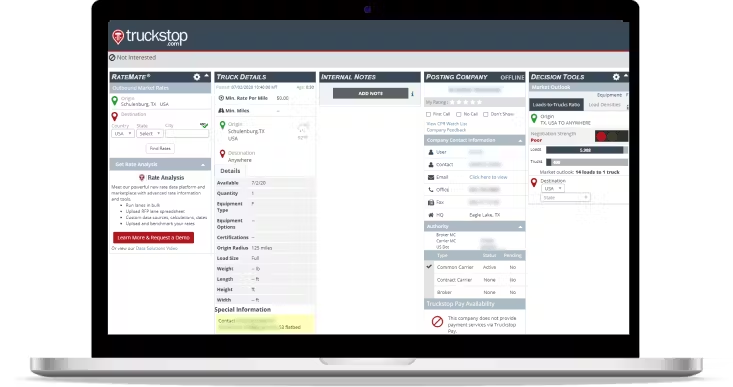Freight Broker Business Plan

Listen up!
Check out our podcast, Freight Nation, where industry experts talk all things trucking.
As the name implies, a freight broker business is the link between freight shippers and carriers. As a freight broker, you will receive requests from companies that need goods shipped and match them to carriers for transport. But how do you make that happen? How do you take your freight broker business from an idea to a reality?
Like any successful business, a freight brokerage needs a business plan. Think of this as a living document that guides your full company lifecycle from startup. Your freight brokerage business plan should evolve along with the company while also guiding its strategic growth.
In this post, we’ll explain best practices for setting up your freight broker business and how to create your freight broker business plan.
Essential steps before starting your freight brokerage.
Before you sit down to write your freight brokerage business plan, you’ll need to take care of some housekeeping steps. These tasks will ensure that your company is legally ready for business. The good news is, you should only have to do most of them once (though some require annual renewal).
- Register your freight broker business. This is a critical step that requires a major business decision. How will you structure your company? Will you choose a sole proprietorship, a partnership, or a limited liability company (LLC)? The choice you make will affect everything from your taxes to the amount of personal liability you assume. It’s best to check with a business attorney and a tax professional before making your decision.
- Get an employer ID number. Except for sole proprietorships with no employees, most businesses need an employer ID number (EIN). This is an IRS-generated identifier that works similarly to a Social Security number, only for companies instead of individuals.
- Apply for broker authority. Next, submit an application for broker authority along with the $300 fee to the Federal Motor Carrier Safety Administration (FMCSA). This is what allows you to legally broker transactions between shippers and carriers. You can apply online to immediately get your motor carrier number, but you won’t have broker authority until you complete the rest of the process. You’ll need to choose a process agent in each state where you do business or select a national company covering every state.
- Purchase a surety bond. The FMCSA requires freight broker businesses to purchase a surety bond for $75,000. However, you don’t need to put up all that money yourself. Instead, you can pay a surety bond company a small premium every year to guarantee your bond. The yearly cost varies by credit score, but it’s typically no more than 4% of the total bond (about $3,000 per year).
Acquire contingent cargo and general liability insurance. Insurance is essential for freight broker businesses. So many things can go wrong on the road, from missed deliveries to freight damage or personal injury. Pairing contingent cargo and general liability insurance provides a strong blanket of protection.
9 steps to write a freight broker business plan

Historically, freight brokerage business plans were formal documents. These days, they don’t have to be quite as formal, but all business plans follow a standard 10-part format. Include the nine following sections in your freight broker business plan to cover any future scenario, from raising money to potential expansion. You can use a free freight broker business plan template or write your own.
1. Executive summary
Although this is the first section of your freight brokerage business plan, you should write it last. This section summarizes the rest of your plan and helps potential investors, partners, or other stakeholders quickly understand:
- What your company does
- Who runs it
- Your customer base
- Why your business will succeed
- What the financials look like
2. Company overview and leadership
Describe your company in this section. For example, do you broker local shipping? National? International? Help the reader understand exactly what you do.
Include brief leadership bios, explaining who will run the company and how their background has prepared them for their role in the freight broker industry.
3. Industry analysis
In this section, take the reader through the freight broker industry as a whole. Is it expanding? By how much, and over what period of time? Include any market factors affecting the industry, such as increases in same-day shipping or online shopping.
How does the market look financially? Are revenues growing? Are there revenue sources that didn’t exist five or 10 years ago? Offer some details, making sure to connect them specifically to freight brokerage (vs. just shipping as a whole). You can use tools like Truckstop’s Spot Market Insights to get the latest intel on rates.
4. Customer analysis
Dig into the demographic details of your target city or cities. How big is the area? How many people live there? How much freight goes in and out of the area? You’ll also want to look at customer segmentation. Are you targeting small businesses? Large businesses? What about fleet sizes? Define who you plan to serve.
5. Competitive analysis
Every company has competition, and potential stakeholders will expect you to know the major players in your space. Write a paragraph or two about each of your direct and indirect competitors.
Then create a competitive advantages subsection and choose one competitor to discuss in more detail. List what the company is doing right. Hass it built strong customer loyalty? A stellar reputation? A top-notch management team? This is the time to show that you understand best business practices.
6. Sales and marketing plan
Marketing includes advertising but involves much more. First, define your unique “value proposition” — how you’re different from the rest. This is a simple statement that covers your core services, along with value-added factors like top-quality customer service or affordable pricing. Whatever you choose, it should set your company apart from your competitors.
Talk about the different ways you will market your company. What sort of advertising will you do? What about public relations? Are you planning to offer loyalty rewards or referral bonuses? Go into detail about how you plan to attract and retain customers, and get them to pay for your services.
7. Operations plan
Divide this category into subsections. Start with functional roles. Explain how many people you plan to hire (if any) and what their job duties will be. You don’t have to go into too much detail. But divide the roles into general categories, such as operations and administration, and briefly describe the major roles within each category. Of course, if you’re running the entire operation yourself, that’s fine, too. Describe what you will do and how.
The next subsection should detail several upcoming milestones. These may include hiring and training staff, building out your facility, and similar startup steps for a new company.
8. Financial plan

This section may be intimidating, especially if you don’t have a background in finance. But it’s basically just a breakdown of where your revenue comes from and what expenses you expect to have. If you’re seeking funding, this is the place to lay out how much you need and how you’ll spend it. You’ll also want to define key assumptions, such as the number of individual loads you expect to receive each year for the first five years and what fixed costs, such as your annual lease fees on your business property, you expect to pay.
From there, you can create five-year documents showing your projected income, cash flow, and balance sheets. You should also list the date you plan to break even or start bringing in at least as much money as you’re shelling out. No one expects these details to be entirely accurate, but they should reflect your best guess based on your research.
9. Description of services
This is an optional section, but it can be helpful, especially for investors who are not familiar with how freight brokerage works.
Use a broker load board to find quality carriers and shippers.

Truckstop connects tens of thousands of carriers, shippers, and brokers through its complete technological solution. It includes freight matching, planning and tracking tools, transportation management systems (TMS), real-time rate analysis, and innovative payment solutions. Truckstop also fully integrates with most of the major software solutions in the industry. With the Truckstop Load Board for brokers, you can make the connections you need to succeed with your new freight brokerage company.
Topics:
Get helpful content delivered to your inbox.
Sign up today.
Find high-quality loads fast, get higher rates on every haul, and access tools that make your job easier at every turn.





